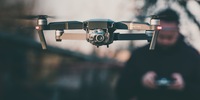

Night pictures with a drone - is that possible?
On sunny days, drones fly out of their hives like bees and take photos or make spectacular videos. When night falls, the sky is usually quiet. I find out whether there are really no good photos or videos in the dark.
I've been toying with the idea of taking long exposures with a drone for some time now. I shouldn't really expect any really good results. Anyone who has ever taken photos at night with a large camera or smartphone will know that the images are usually blurred, too dark or grainy. Long exposure times are necessary and a tripod is the only way to keep the camera completely still. But the drone is hovering somewhere in the air and is anything but steady. At least that's what I thought.
In theory
I grab the new DJI Mavic Pro 2. The drone's camera is equipped with a relatively large 1-inch sensor and should therefore cope better with poor lighting conditions than, for example, the Mavic Pro Zoom or Parrot Anafi, which are equipped with much smaller sensors. Even more important than the right device are the correct settings in the app and a location with artificial light such as moving cars, sports fields or illuminated streets.
The DJI app can be used to switch to manual photo mode during the flight in order to adjust the settings. All standard parameters such as ISO, exposure time and aperture can be set in this way. Photos can be exposed for a maximum of eight seconds.

What can go wrong in practice
On one of the countless beautiful October evenings, I venture out into the dark. On my way to the place where the cover picture was taken, I pass an illuminated football pitch. A perfect subject - especially when there is a busy road next to it. Even the first results surprise me positively. I can recognise moving cars by their headlights. The headlight tails are rather short at the beginning and the image is far too bright due to the bright pitch lights. I change the parameters until I like the picture.
On arrival at the second location, I notice a red tail at the top and bottom of some of the photos. These are the lights from the drone. Fortunately, I know that there is a setting somewhere in the menu to switch them off.



Once the "Turn on Aircraft Arm LEDs" tick has been removed, you can take photos from the perspective of a night owl. A good photo is usually not taken on the first attempt. Especially not when the camera is hovering. I try out different settings until I get an image that I like. What's more, there are always blurred pictures. Probably because the drone moves very slightly. But it's amazing that I still manage to take a lot of photos and the drone can stay in the same spot for 4-8 seconds.


A selection







The photos are also convincing in terms of sharpness despite the long exposure time. To clarify: If I cut out the area marked in blue from this image, the photo still looks good.


Hyperlapse
In addition to long exposure photos, the new DJI drones are able to automatically produce hyperlapse shots. A hyperlapse is nothing more than a timelapse in which the camera is in motion.
The parameters can also be freely adjusted in this mode. However, photos can be exposed for a maximum of 1/25 sec. The ISO value must therefore be adjusted upwards accordingly. Nevertheless, spectacular shots can be taken that are well worth seeing. Different shooting modes can also be selected via the app so that the drone simply flies straight ahead, makes a circle around an object or flies along a previously defined route. There are virtually no limits to creativity and these hyperlapse shots are of course also possible in daylight.
I didn't expect this
I'm pretty impressed with these night shots. A photo shot by hand and exposed for 4-5 seconds with a "normal" camera would almost certainly be blurry. The drone can handle this and takes sharp photos. Countless sensors such as GPS etc. contribute to this. If I've inspired you to try it yourself, I'd be delighted with any photos you send me ;)
Inform yourself about your location
After my drone flight on the outskirts of Rapperswil, I realise that there is a small airport very close by on the other side of the lake. Flying is not allowed five kilometres around airports. Next time, I'll check again before I fly. You can find out what else to consider when flying drones here: [[marketingpage:4118]]
As a Multimedia Producer, preparing multimedia content and knowing about cutting-edge technology is my business. My main focus at digitec is producing videos. I can’t wait to try out new products such as cameras, drones or smartphones as soon as they’re launched. This is where being at the source comes in rather handy. When I’m not working, I’m probably skiing, biking or hiking – the mountains are my place to be.


